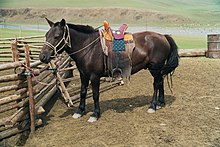Mongolian Pony

A Mongol horse (with trimmed mane) in traditional riding gear
|
|
| Country of origin | Mongolia |
|---|---|
| Traits | |
| Distinguishing features | Small but sturdy build, stamina, hardiness in extreme conditions, genetic variation |
The Mongol horse (Mongolian Адуу, aduu: "horse" or mori; or as a herd, ado, or in Northern Khalka, tabun) is the native horse breed of Mongolia. The breed is purported to be largely unchanged since the time of Genghis Khan. Nomads living in the traditional Mongol fashion still hold more than 3 million animals, which outnumber the country's human population. Despite their small size, they are horses, not ponies. In Mongolia, the horses live outdoors all year, dealing with temperatures from 30 °C (86 °F) in summer down to −40 °C (−40 °F) in winter, and they graze and search for food on their own. The mare's milk is processed into the national beverage airag. Some animals are slaughtered for meat. Other than that, they serve as riding and transport animals; they are used both for the daily work of the nomads and in horse racing.
Mongol horses were a key factor supporting the 13th-century conquests of the Mongol Empire.
Mongol horses are of a stocky build, with relatively short but strong legs and a large head. They weigh about 600 lbs. and range in size from 12 to 14 hands (48 to 56 inches, 122 to 142 cm) high. Their cannon bone external circumference is about 8 inches (200 mm). They have a slight resemblance to Przewalski's horse and were once believed to have originated from that subspecies. However, that theory was disproven in 2011 by genetic testing. Przewalski's horse has been conclusively shown not to be an ancestor of any domestic horse, though it can interbreed with domesticated horses to hybridize and produce fertile offspring. Of the caballine equines, E. ferus, only E. ferus ferus, also known as the European wild horse or "tarpan," shares ancestry with the modern domestic horse.
The mane and tail of the Mongol horse are very long. Their strands are often used for braiding ropes; the tail hair can be used for violin bows. Mongolian horses have great stamina; although they have small bodies, they can gallop for 10 km without a break. When pulling a cart, a team of four Mongol horses can draw a load of 4400 lbs for 50–60 km a day. Because the horses are allowed to live much the same as wild horses, they require little in the way of hoof care. The hooves are left untrimmed and unshod, and few farriers are in the country. Mongol horses have hard, strong hooves and seldom have foot problems. Sometimes, horses will be branded.
...
Wikipedia
